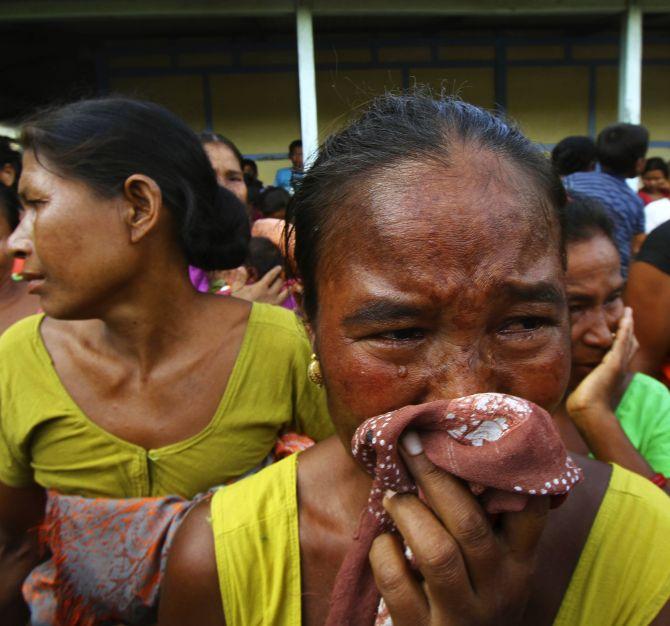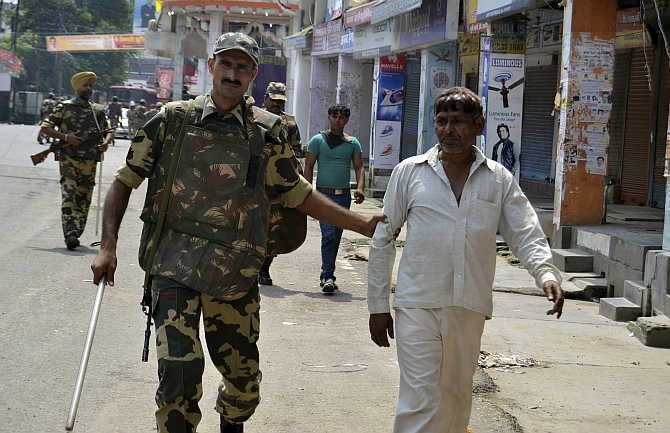Photographs: Utpal Baruah/Reuters Vicky Nanjappa
The National Integration Council is meeting on Monday to discuss the recent riots at Muzaffarnagar in Uttar Pradesh in which 50 persons died and 4,000 were rendered homeless. A great concern is that over the past 60 years India has not found a way to deal with the causes of riots and has not succeeded in curbing them.
Mihir Bhat, fellow at the Harvard Humanitarian Initiative who is also the director of the All India Disaster Mitigation Institute, discusses with Rediff.com’s Vicky Nanjappa about what the National Integration Council should focus on.
We know that the worst-affected in any riots are the poorest citizens. May it be religious riots or riots to protest for or against formation of new states or districts or caste-related riots -- it is the handloom weaver, the bidi roller, the casual construction labour, forest gum collector, farm hand, or chai-walawho is worst affected. But why?
Why mostly poor continue to suffer both the economic and human insecurity during riots in India?
We know that after riots, poor food security and malnutrition continues over a fairly long time. Access to food and nutrition by the victims go down, worst affecting growing children and new mothers. Why are our food distribution system and food markets not resilient to riots?
Women suffer more and longer from the violence and its impact. Hardly any riot photo essay misses out capturing the saddest impact on women. But riot after riot the number of women affected has not gone down.
Loss of jobs or livelihoods is as painful as loss of life in a riot and yet we do not have any systematic way of assessing loss and damage after riots. Who lost what and how remains a contested area in India causing unending acrimony leading to reasons for next riots.
The 24-country strong International Conference on Loss and Damage Associated with Climate Change in the Asia Pacific: Integrating Scientific Aspects, which met in Bangkok last month, discussed that accurate assessment of loss and damage is the basis of any step ahead towards recovery or compensation. What is true for climate change related losses is also true for losses due to riots: poorly done assessments lead to poor justice and compensation.
Please …
'Riots are not just a law and order issues'
Image: A jawan detains a person for questioning in curfew-hit Muzaffarnagar following communal clashes.Photographs: Reuters
After riots the overall access to health and education, and their quality go down and take over decades to come up to pre-riot levels. Women’s reproductive health levels go down, so do children’s health and growth after riots. Old people have difficulty accessing public healthcare due to safety reasons. Occupational health services almost disappear for labour and their families. Why India’s social protection measures are still so fragile against riots?
We know that riots in cities take up their own form and function to soon make cities or their parts unlivable for a long time: may it be Delhi or Ahmedabad, Bangalore or Hyderabad. Urban riots develop their own life and yet no city plan in India deals with assessing and curbing future riots. Riots remain a matter of law and order alone, and in the hands of the police.
Environment degrades and natural resources are mismanaged after a riot in tribal or rural areas. The tribals in tea estates in Assam and in mining operations in Odisha and Karnataka have experienced a disjoint.
Riots overlap with disaster risks making the citizens doubly vulnerable. The district disaster management plan review in Assam pointed out that one risk attracts another risk; risks have natural tendencies to pool, and spill over. And yet hardly any district disaster management plan in India, including those in riot-prone districts, include riot as a possible disaster.
Accountable and responsible governments accelerate riots recovery. The ongoing research work of Active Learning Network for Accountability and Performance in Humanitarian Action in United Kingdom on national authorities indicates learning and improvement by governments affected by humanitarian crises is unsystematic and is not uniform across countries.
Though India has set up distinguished list of commissions of inquiries after riots, over decades hardly any effort has been made to study what state governments have learned from these reports and the processes.
The Inter-State Development Council can take up a review of learning from riots and improvement of institutions and processes by state structures.
Strong and joint action by civil society, private businesses, and authorities make recovery from riots faster and better.
Dr. Dorothea Hilhorst, author of “Disaster, Conflict and Society in Crises: Everyday Politics of Crisis Response” tells us in her recent book so clearly that local institutions act and transform in response to crises, that conflicts are breakpoints of social order, but conflicts also open up processes of new types of continuity and re-ordering of society including creation of new linkages and institutions. Crisis is an opportunity to heal and build a healthy society.
None of the above points are new or original to anyone, and certainly not to the members of the NIC. Time has come for the NIC to go beyond “who caused the riots and how” to shape and strengthen different arenas of interventions in crisis to find long-lasting and creative ways of reducing riots -- ways that measure up to India’s long tradition and rich cultural history of unity in diversity as well as upcoming but uncertain glory of economic growth.



article